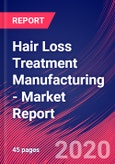New Growth: Despite Revenue Growth, Generic Alternatives Will Threaten the Industry
Hair Loss Treatment Manufacturing
The Hair Loss Treatment Manufacturing industry exhibits a low level of market share concentration, with no single player operating more than 5.0% of industry market share. This market fragmentation can be partly attributed to the plethora of products available, including oral and topical treatments, laser therapies and restorative hair treatment. Over the five years to 2019, market share concentration has remained low and is not forecast to increase significantly moving forward.
Generic alternatives enter the market
- While only two products have been approved by the US Food and Drug Administration, including Propecia and Rogaine, as well as their respective generic versions, Finasteride and Minoxidil, the market remains heavily fragmented. Over the five years to 2019, many name-brand industry products have lost patents and other protective rights, allowing generic alternatives to enter the market. Additionally, as certain brand-name companies lost their patent exclusivity, generic substitutes have emerged, cutting into revenue for key industry operators. Merck & Co. Inc. (Merck), which manufactures Propecia, lost market exclusivity for the product's active ingredient, Finasteride. In response, many generic manufacturers of this medication are now active in the industry, including several store-brand products. A further example is Hims, a new direct-to-consumer start-up that launched in 2017, which markets specifically to men, selling generic hair loss treatment and skincare products at much lower costs than traditional brands. Other new products are also flooding the market, including a range of hair implant options and an innovative laser comb called HairMax made by Lexington International LLC.
Patent removals and generic alternatives boost internal competition
- The Hair Loss Treatment Manufacturing industry has experienced a moderate, but increasing level of internal competition that is primarily driven by the removal of patents in recent years and the introduction of several generic and over-the-counter products. As more manufacturers enter the industry, the products available on the market increase in number and effectiveness. This growth expands options for consumers, who can choose a product based on price, availability and efficacy. Operators that are a part of or associated with larger brands, such as Johnson & Johnson, have a slight competitive advantage, however, as they have access to well-funded and large research and development labs. This could help these brands establish a competitive advantage and market products with new patents.
This industry develops and produces solutions that prevent or restore hair loss. Products in this industry include topical applications, orally ingestible treatments, hair transplants and laser follicle stimulation.
This report covers the scope, size, disposition and growth of the industry including the key sensitivities and success factors. Also included are five year industry forecasts, growth rates and an analysis of the industry key players and their market shares.
Table of Contents
Methodology

LOADING...








